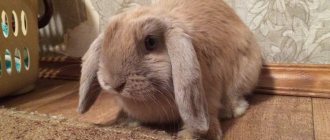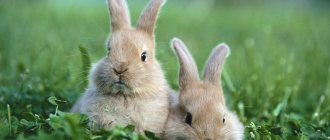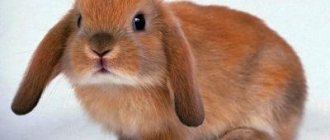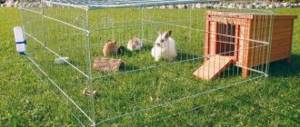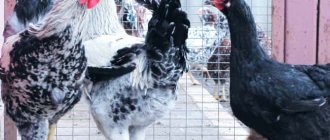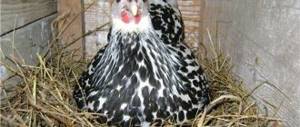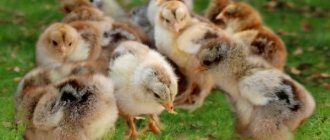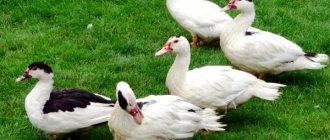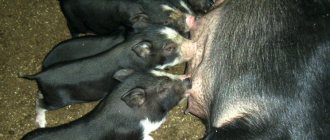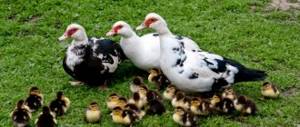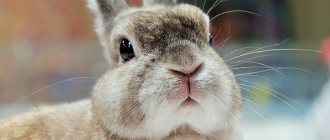Expert opinion
Dobryshev Sergey Anatolievich
Professional rabbit breeder and hare breeder with 30 years of experience
Even people who are far from breeding rabbits can easily distinguish this breed from others due to their original appearance. Ram rabbits resemble these farm animals in appearance, which is how they got their name. Distinctive features are long hanging ears and a peculiar small hump on the nose.
Keeping and breeding sheep rabbits is not difficult. But some of them are especially lucky - thanks to their attractive and original appearance, they are used as pets. They are the largest among representatives of decorative rabbits.
History of origin
The ancestors of most of the modern breeds of animals were residents of Mediterranean and Western European countries. The ram rabbit breed group was first developed in Great Britain. This happened in the middle of the 19th century.
At first, floppy ears were recognized as a mutation. Then the breeders decided to consolidate this trait and make it a characteristic feature of the new breed. It was this that allowed rams to gain great popularity in many countries. The most striking thing is the hanging ears - their length reaches 70 cm and width - 17 cm. Sometimes, for convenience during inspection, you have to secure them on the head with a special clip.
History of the breed
Ram rabbits are descended from a wild population of these mammals of the hare family, living in Western Europe and the Mediterranean.
The breed was finally developed in the mid-19th century in Great Britain. The mutational trait of the variety - drooping ears - was obtained by chance and fixed during further breeding work with English lop-eared rabbits and Flemish giants.
They are associated with the ram because of their steep head, small hump on the nose and drooping ears.
Most of all this breed is bred in Germany and France.
Existing varieties
After gaining popularity in France, Belgium, Holland and Germany, these countries continued selection and developed their own subspecies of ram rabbits. Thus, the following varieties appeared:
- English Fold. He is the progenitor of this breed.
- French ram. Large weight is attractive for breeding for meat production.
- Meissen ram. The name comes from a city in Germany. The result of mating an English species with a French one.
- German ram. A short muzzle with a wide forehead and a flattened nose.
- Dutch view. Has dwarf size.
- Hairy ram. Their small size allows them to be classified as a dwarf rabbit.
- Dwarf ram. Best known in European countries.
- Velveteen ram. It got its name from its velvety wool.
Each variety clearly has a “trademark” - lop ears.
Description
Rams are easily recognized by their characteristic hump on the nose and drooping ears. In some individuals, the ears can reach a length of more than half a meter, so for convenience they have to be pinched with special clips. A wide forehead and round, thick cheeks are also considered distinctive features of Rams. Their eyes are large and expressive.
Hanging ears give Ram rabbits a special charm and cuteness. However, this structure of the ears makes the animals less susceptible to environmental sounds, so they are not afraid of rustling sounds and can notice impending danger late.
Rabbits have impressive muscle mass and are well developed physically. The average weight of an adult rodent reaches 4-5 kg, but there are also individuals weighing more than 10 kg. They have thick, long and soft fur. The most common animals are black, blue, red and brick in color.
Rams have a peaceful disposition and easily get along with any other inhabitants of the farm. They are easy to train, recognize their owner, and love to interact with him. With proper care, rabbits live on average about 10 years.
Standards and marriage
The Ram rabbit breed includes many subspecies that differ in both the size of the individuals and their external characteristics. Each such subspecies has its own clearly established standards. But there are some common traits for all Rams:
- large head with a wide forehead;
- long drooping ears;
- crook in the nose;
- round cheeks;
- massive body;
- precocity;
- thick coat.
Individuals with a narrow chest and poorly developed muscles are considered to be a defective breed. In purebred rabbits, their ears are already in place at the age of 2-3 months. They should not fit too close to the head or stick out. Short (less than 24 cm) or narrow ears are also considered a fault.
Appearance and character
Ram rabbits have a wide chest, a large head, a sloping forehead, and plump cheeks. The average weight is 4.5 kg, the largest individuals can reach up to 11 kg. The maximum body length is about 70 cm. The coat is thick and can have different shades. The fur has a good undercoat.
A newborn rabbit's ears do not fall down immediately. At first, they may stick up or be moved to the side. This is not a deviation from the norm.
The ram rabbit has a calm character. He quickly becomes attached to his owner and is easy to train. Begins to recognize his nickname and respond to it. The state of some phlegmaticity and constant calm can be partly explained by insufficiently good hearing.
Feeding schedule
Food for rabbits is usually placed in enclosures or cages three times a day. In the morning and evening, the animals are most often offered concentrates, and during the day - root vegetables. Rabbits can be given grass at every feeding. It is this diet that helps animals quickly gain body weight.
Of course, rabbits in enclosures and cages, among other things, should always have clean, fresh drinking water. Its presence should be checked and, if necessary, changed at each feeding.
English Fold
The English lop-eared ram belongs to the category of large ones. Their weight starts from 4.5 kg. It is difficult to keep giants indoors, so they are used for meat and fur pelts. This variety of ram does not have a “crown” between its ears. The ears hang down under the influence of their own, quite considerable weight. The width of each ear is a quarter of its length. The tips of the ears are rounded. The color of various colors can be solid or have tan marks.
English rams are heat-loving because a lot of heat is lost through the large surface of the ears. The sociable nature of the English requires interactions with them as part of caring for them. Giants need to be provided with plenty of space for their permanent residence.
French ram
Rabbits of the French Ram breed are valued by breeders when breeding for meat. One of the main advantages is heavy weight. It can reach 12 kg. The average length of the elongated body is 60-70 cm.
The large head has a sloping forehead and heavy, plump cheeks. On a short and strong neck, a wide, round muzzle is set high. The hair on the head is shorter than on other areas. The downward-hanging mustache is of medium length. Large eyes may be red or blue. The ears can hang 4 cm below the chin. Their width is 15 cm, length is in the range of 20-40 cm. The ears have no folds.
The limbs have different lengths - the front legs are shorter, and the hind legs are longer and more massive. The short tail fits tightly to the body.
The character of French rabbits is calm and balanced, which is why they are often used as pets. They easily get used to their owner and are friendly towards other pets. Thanks to their developed intelligence, Frenchies are easy to train and follow commands.
French sheep produce high-quality dietary meat with a delicate taste. Their productivity is considered high. Smooth wool is pleasant to the touch. The length of the fur is about 3 cm. Valuable fur has different colors. Not only one color is allowed, but also a combination of two shades. The skin is large in size and of high quality.
Puberty in males occurs at the age of 5-6 months, and in females somewhat later - at the age of 8-9 months. One litter consists of 5-8 newborns, sometimes reaching 12.
Despite their weak immunity and susceptibility to diseases of the digestive system, French sheep can be called long-livers - with proper care they can live up to 9 years.
French ram rabbit - description and photo
The key distinguishing feature of this breed is its long (up to 45 cm) hanging ears, like those of a basset hound. Moreover, among all fold-eared breeds, French rams are distinguished by the largest sizes - up to 70 cm in length. Interestingly, females weigh slightly more than males: about 5 kg versus 4.5 kg.
The standard exterior of French ram rabbits is as follows: a wide muzzle with protruding forehead bones (which is why the animal resembles a ram, after which the breed is named), heavy cheeks, an elongated body, a wide back, strong legs.
Also, French sheep rabbits have quite beautiful fur, pleasant to the touch and very thick. For this reason, the breed is sometimes classified as a meat-and-skin breed rather than simply a meat breed.
For a long time, the agouti color predominated in the breed, but today the range of colors is extremely wide and includes almost any options: chinchillaChinchilla is a rodent from the chinchilla family, outwardly similar to something between m..., blue, all shades of gray, white and black, as well as motley the color that is most common.
Ram rabbits have a very calm and friendly disposition. In addition, their floppy ears make them much less susceptible to loud noises, which is why rabbits are also much less timid than their counterparts of other breeds.
As already mentioned, the French sheep rabbit is only one of several varieties of the breed, or one of the closely related breeds (depending on how you approach the issue of classification). In addition to it there are also:
- Dutch,
- corduroy,
- Meissen,
- nappy,
- German,
- English
- and dwarf ram.
Due to its small size, the dwarf ram rabbit is completely unsuitable for breeding for meat, and therefore is used exclusively as a pet. The English rabbit has the potential to be bred for meat, but due to difficulties with its breeding, it is also almost never used for this purpose.
Meissen ram
They got their name from the city of Meissen in Germany, where they were bred at the end of the nineteenth century. The difference is the thick shiny fur, which has different shades. Common to all colors is “silvering”, which imparts a unique beauty. The main colors include: black, blue, Havana and agouti.
Expert opinion
Dobryshev Sergey Anatolievich
Professional rabbit breeder and hare breeder with 30 years of experience
Rabbits of this breed are considered medium-sized. Their weight does not exceed 5.5 kg. The muscular torso has an oblong shape. The physique is compact.
Meissen rams are active but calm in character. They grow and reproduce well. The number in one litter is 8-12 rabbits, which the female rabbit feeds with her milk. Meat with a small amount of fat is dietary.
German ram
The German ram rabbit is the result of crossing French and English rams with Flanders rabbits. The result was a compact animal with a stocky, massive body, drooping long ears and a “Roman” nose. The forelimbs are straight, short and strong. The rear ones are shorter.
The size of German sheep is average - from 2.9 to 3.9 kg. The color has a variety of shades. Characteristic, like those of its relatives, are the ears. They hang down the cheeks without covering the eyes or interfering with vision. The length of the ears is 28-35.5 cm.
The medium-length coat is dense, dense and soft. The thick undercoat causes intense shedding, which leads to the need for intensive cleaning during this period.
The calm, dispositional nature makes it possible to use German sheep as pets. The good maternal qualities of females allow them to care for strong, healthy German lambs.
Maintenance and care
In general terms, the care and maintenance of rams does not differ from ordinary breeds, if we consider the place or nutrition of these animals.
But if you want to have an English ram, you will have to worry about the cleanliness of the cage. Ears that drag along the floor will constantly find dirt. The animal can also injure its ears on something sharp while walking around the house.
A long-haired or lion-headed ram will require careful grooming, as during the molting process it can ingest hair while cleaning its skin. If the fur forms a lump in the intestines, the rabbit will not live longer than a couple of days.
To prevent this problem, the animals are given malt paste, which dissolves the fur. And don't forget to comb them.
At home, lop-eared rabbits eat the same things as other decorative pets of this species. They are given feed, observing the requirements for hay, feed and succulent feed.
With good care, rams live as long as their relatives with erect ears live, that is, 6 – 12 years.
Dutch ram
A distinctive feature of the Dutch ram, like its counterparts, is its long ears hanging down its cheeks. The ears can reach 30 cm in length. The muscular system is well developed. The size is not too big. The average size is 15-20 cm. Adults weigh no more than 2 kg.
The fur is thick and soft, making you want to touch it. It has a fine texture and is uniform. The character of Dutch rams is peaceful but active. The large head is set on a short neck. The shortened muzzle has full cheeks.
On average they live up to 10 years. With decent care and proper feeding they can live up to 13-14 years.
fleecy ram
The name of the subspecies reflects the presence of fluffy fur. Fleecy rams are bred from Dutch Fold rabbits. They have a small weight - up to 1.8 kg. The coat is impressive - long and lush. The colors have more than twenty shades to suit every taste. The short muzzle has a very cute and attractive appearance. This breed is suitable almost exclusively for keeping at home. Wool requires constant care.
Varieties of rabbits rams
The breed of decorative rabbits, rams, is not uniform in its structure. Several varieties have been developed in different countries. Today the following subspecies are known:
- English
- French
- German
- Meissen
- Dutch or dwarf
- Nappy
- Plush or corduroy
Subspecies have their own characteristics, but they are all united by common features, which are described above. Breeding is best done within the same breed to maintain specific characteristics. Below is a brief description of the main subspecies.
English ram
The English Ram rabbit breed was the first to be bred, and many other subspecies originated from it. These animals have very long ears, about 60 cm. The length of the record holders is 71 centimeters. Another feature is the shortened front and elongated hind legs. Because of this characteristic, the back of the case appears to be raised upward. The weight of rabbits is 4.5-5 kg. English sheep are very attached to their owner; if they are not properly cared for, they can become wild.
French ram
The French ram rabbit was obtained by crossing a German giant with an English fold. The result is a real giant with drooping ears and a specific muzzle. They have a wide head with plump cheeks, an elongated and widened back, and a large chest. The length of the ears is about 45 cm. The coat color can be different - red, blue, gray, black, white, Madagascar, etc. The weight of an adult is 4-8 kg. To keep massive rabbits at home, spacious cages are needed.
German ram
The German Ram rabbit has a short muzzle with a flattened nose and an extended jaw. The forehead is wide, between the hanging ears there is a peculiar elevation, reminiscent of a crown. The body of rabbits is not very long, but widened, with a short neck. Average weight – 4-9 kg. German fold rams originate from French ones and were bred in 1933.
Meissen ram
The Meissen ram was bred in Germany in the century before last. Today the breed is considered almost extinct and is under protection. The animals have a large head with plump cheeks and a strongly curved nose. The fur grows luxuriantly between the hanging ears, forming a crown. The body is slightly elongated, stocky; females may have a slight dewlap. The fur evenly covers the entire body, its structure is smooth, and the colors can be any except silver. The Meissen ram rabbit is medium in size and weighs 3-5 kg.
Dutch ram
Dutch ram rabbits are typical ornamental animals. They have miniature sizes, the animals weigh 1.3-1.8 and are considered the smallest among their fold-eared counterparts. The body of rabbits is short and wide, the legs are plump. The fur is fluffy and soft to the touch, and comes in any shade. The Dutch mini rabbit is considered the smallest breed among sheep. Its breeding as a pet has become very popular among Europeans.
fleecy ram
The ram fleecy rabbit is a very young breed bred in the USA based on the Dutch Fold rabbits. It has a wide variety of colors; about 20 shades are officially recognized. The fur of fleecy rabbits is very fluffy and requires constant care and combing. The muzzle is shortened, like the body, so the animals resemble small balls. The weight of fleecy rams is 1.6-1.8 kg. These animals are kept at home as decorative animals.
Velveteen Ram
The Velveteen Fold rabbit is a very young variety. Its breeding began several years ago in Australia and is still in its infancy. The rabbit was named plush or corduroy because of the special structure of its fur. It is short and soft, reminiscent of corduroy. The fur of Rex rabbits has a similar feature. The plush ram weighs 3-6 kg. Keeping it as an ornamental animal is becoming increasingly popular.
Dwarf ram
Dwarf rams acquired their modern appearance after twelve years of persistent selection by Dutch breeders. The charming face evokes affection. The physique is neat, well-knit, and proportional. The body has a cylindrical shape, the muscles are well developed. The chest is wide, the neck is short.
Beautiful, slightly sad eyes are almond-shaped. Wide brown iris, large round pupil. The oval-shaped ears hang 1.5-2 centimeters below the chin. The antennae on the muzzle are thin, long, and light-colored. The animal's legs are short but powerful. The tail is short and fluffy. The claws on the paws are arched and pointed. A variety of dwarf ram is the lionhead. It is not difficult to imagine who his head resembles due to the presence of a long mane.
Little female rabbits begin to bear offspring as early as six months of age. In one litter, the female gives birth to 5-7 newborns and feeds them with her milk for a long time. The character of dwarf rams is friendly, calm and flexible. Since they are used as pets, it is important that they play well and affectionately with children. However, when letting him wander around the apartment on his own, you need to keep an eye on him so that he doesn’t chew through wires and other important things.
Despite the small size of the animal, you should purchase a spacious cage so that its large ears are not injured. Toys for his leisure time should be placed in the cage. It could be a ladder or a slide. You should talk to animals in a calm voice; screaming is unacceptable and can cause stress. It is also necessary to ensure that there are no drafts, which can lead to colds.
Maintenance, care and feeding
Sheep rabbits cannot tolerate excessive heat and drafts, so you need to carefully select a place to keep them. If you plan to keep an animal in a cage, then it should be spacious (more than 60x80cm, the larger the better for the pet).
As a rule, rabbits are active at dusk and at night. It is necessary to periodically let the animal out for a walk and run around the room (apartment).
Note that the cage must have a reliable metal lock.
The first time they stay in a new place, rabbits and rams huddle in a corner; any sharp sound is very painful. This is a completely normal desire to hide from danger.
It is necessary to trim your pet's nails regularly. In order for him to grind down his incisors, you need to give him solid food. Otherwise, he can choose items for himself while walking around the house.
The decorative ram rabbit is trainable, so it can be easily taught to relieve itself in a litter tray. During walks, the little bunny will return back to the cage in order to do its “business” to the toilet.
If the dwarf rabbit ram has long hair, then it needs to be combed periodically using a special brush.
Large sawdust should be used as bedding. The cage should always have fresh water and branches of fruit trees, as well as chalk.
You need to feed with succulent feed and hay. It is also necessary to buy ready-made dry food, but do not abuse it.
Add fruits and vegetables to your diet in small quantities.
You need to clean the cage, like the tray, when it gets dirty, about 3 times a week.
Velveteen Ram
Even pronouncing this name, there is a desire to stroke these animals. Corduroy sheep have an average size, reaching only up to 3 kg. The type of folding can be called semi-arched. The color has different shades. The harmonious body tapers from the broad butt to the shoulders. The chest is round, the back is wide. The forelimbs are low, which makes the appearance of corduroy rams squat.
They have a small head, sitting on a short neck. Long ears hang down over the cheeks without blocking vision. Ears have a minimum length of 35.5 cm, measured from the tip of one ear along the crown to the tip of the other. The width of the ear is a quarter of its length, which makes it proportional. The ears are dense, but elastic.
The fur of corduroy sheep is thick and soft. Its length is approximately 1.6 cm. The hair, despite its softness, has elasticity. Corduroy Rams are good-natured, calm, and inquisitive. They value attention and affectionate attitude very much.
Feeding the rams
At any age, ram rabbits need food 2-3 times a day. Feeding should be done at the same time every day. Each new product must be introduced gradually. Sheep are known rodents, so they should always have branches of trees and young bushes at their disposal.
According to the season, they should be given vegetables, fruits, and melons. In summer, it is necessary to provide fresh grass as much as possible. Any delicacy is a carrot. Balanced feed is purchased feed, which should be given as an additive to the main feed. The lop-eared menu should also include grain mixtures, in particular wheat and oats. Special granules must be given as vitamin supplements.
For drinking, it is enough to offer fresh drinking water, but always in sufficient quantity.
What to feed a French sheep
A French sheep can chew all the time while it is not sleeping. Feed must be dosed, given 3 times a day, with portions calculated. This breed quickly builds up fat at the expense of muscle mass.
The diet includes:
- summer - grass dried for several hours (burdock, dandelion, clover, nettle);
- hay – without signs of rot, dry, from various grasses;
- cereals – mainly oats and wheat;
- vegetables – carrots, beets, cucumbers;
- fruits (apples, pears);
- melons;
- in winter - compound feed.
See also
What and how to feed a female rabbit after giving birth and how to increase milk productionRead
Tomatoes, legumes, and rhubarb should be excluded from the diet. In winter, hay and feed are supplemented with vegetables so that the sheep can crunch on juicy fruits. Tree branches and crackers help satisfy the thirst for chewing.
The completeness of the winter diet is supported by vitamin complexes with micro- and macroelements. If there are no vegetables and fruits, you can add premixes for rabbits to the food. Chalk and salt are given in small quantities. Give the rabbits warm water; it is convenient to use nipple drinkers.
Caring for lop-eared rabbits
The cage in which ram rabbits are kept must be spacious. This will allow active animals to move freely and even jump inside their home. The cage should have a secluded place to rest. The breed is distinguished by its desire for cleanliness, so the cage must be cleaned of dirt. For reproduction, healthy individuals are selected, after feeding them.
Particular attention is paid to the cleanliness of long ears. To clean them, use cotton swabs. Nails should be trimmed regularly using special nail clippers. Thick coats require constant brushing and brushing. It is also necessary to strictly follow the vaccination schedule and get vaccinated within the period specified therein, protecting against the occurrence of diseases.
